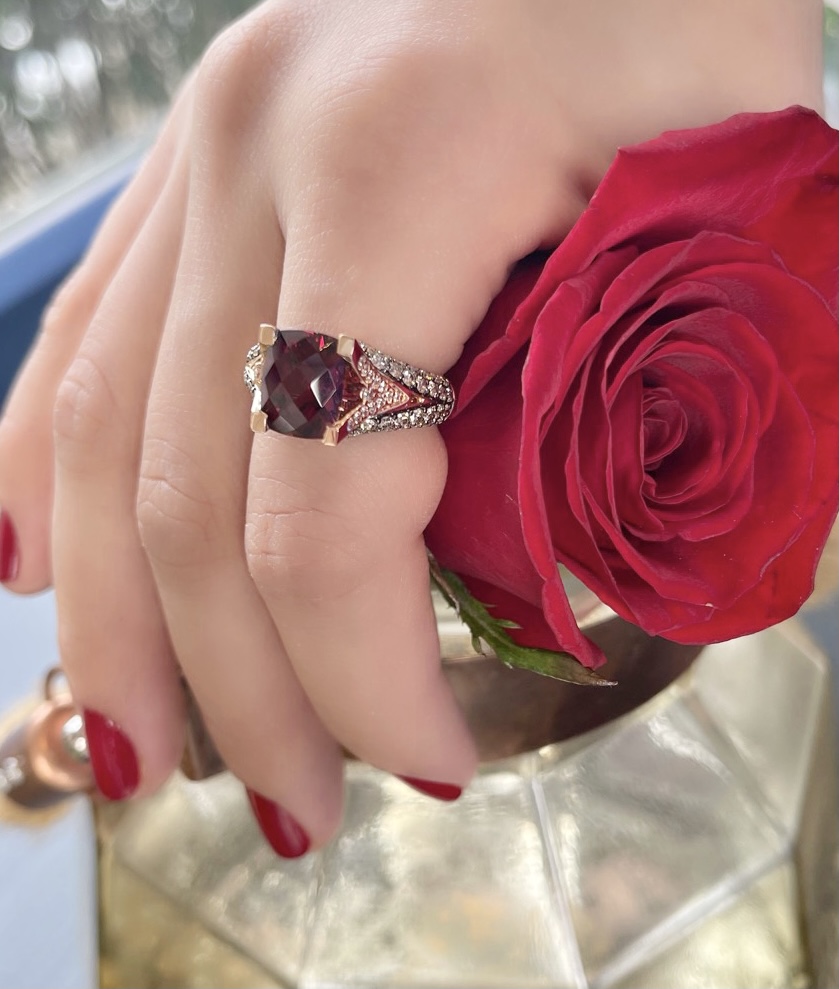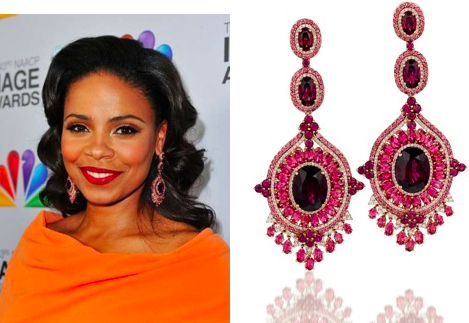January Birthstone: The Electrifying Le Vian® Pomegranate Garnet™ and Raspberry Rhodolite™
We are excited to welcome the fortuitous month of January, and the bright new year, with one of the most intriguing and impactful birthstones: garnet.

Early History
Although this eye-catching gem comes in a variety of colors, classic garnet displays a deep, ruby-red hue. According to the Gemological Institute of America, garnets have a long and storied past dating to circa 3100 B.C. with various points of popularity throughout history: “Garnets have been used since the Bronze Age as gemstones and abrasives. Necklaces studded with red garnets adorned the pharaohs of ancient Egypt. Signet rings in ancient Rome featured garnet intaglios that were used to stamp the wax that secured important documents. The clergy and nobility of the Middle Ages had a preference for red garnets. . . These rich red beauties were [also] extremely popular during the Victorian era (1837–1901).” The great philosopher Plato is said to have had his portrait engraved on a garnet by a Roman engraver. Ancient tribes in Asia believed that the color of garnet has an affinity to blood, injuring the enemy more easily and creating a more grievous wound. Later on, carved garnets were used as ammunition against British soldiers during an 1890 rebellion in the Kashmir territory of India. Garnets even bear Biblical significance, literally; religious scholars point out these scarlet gems as having served as a source of light, in their polished form, on Noah’s ark; a garnet was also embedded on Aaron’s breastplate as one of the famous twelve stones, a sign of incredible beauty and holiness.

Mineral Composition
There are actually six minerals that the term “garnet” can refer to: pyrope, almandine, spessartine, uvarovite, grossular, and andradite; these are a group of silicate minerals that share a structure and are therefore all classified under the same umbrella. One type of grossular, first discovered in the 1960s in Tsavo, Kenya, was named tsavorite by Tiffany’s and today is still sold under that name. The gem usually grows in metamorphic rocks, but sometimes in igneous ones as well. It is fairly tough and usually on the more transparent end of the spectrum, although opaque garnets are sometimes found. Garnets achieve their dazzling color range—from pink/purple to violet/red to yellow/brown—through a naturally occurring chemical mix of iron, aluminum, calcium, and manganese. Garnets measure up to an 8 on the Mohs scale of hardness, making them a favorite for jewelry and favored in rings. Cut often as cabochons, they are referred to in that smooth, rounded form as carbuncles. They are a durable and brilliant stone, perfect for occasion or daily wear.

Healing Properties
The January birthstone is also popular in Indian astrology and beyond, hailed for its inherent mystical properties: “Garnet helps eliminate negative feelings (depression, guilt) and instill greater self-confidence and mental clarity to promote creative thinking and peace of mind. In ancient and medieval times, gems like garnet were also thought to be remedies for inflammatory diseases and to soothe the angry heart.”
While garnet is deemed the primary birthstone for the Aquarius zodiac sign, it is also the secondary birthstone for Leo, Virgo, and Capricorn. In supernatural teachings, it represents the elements of Earth and Fire, and in Ayurvedic medicine, it is aligned to the Root and Sacral chakras. Lore has it that the garnet has powers to illuminate the night, thus protecting the wearer from nightmares. The gem has also been known in superstitious belief to bring luck, wealth, protection and overall good fortune.

Where in the World?
Until the 19th century, garnet was typically found in Bohemia, known today as the Czech Republic. Thereafter, garnet began being mined in the Ural Mountains of Russia (and popularized by famed jeweler and jeweled-egg maker Peter Carl Fabergé). Still later, garnet mines expanded to Brazil, Namibia, Kenya, Tanzania, Madagascar, Myanmar, Pakistan, Sri Lanka, India, Afghanistan, and elsewhere. One famous Fabergé creation features the world’s largest polished garnet, carved from a 5,696 carat stone. The piece is said to be worth near $400,000.

Le Vian® Pomegranate Garnet™ and Raspberry Rhodolite™
Our special version of garnets, ethically sourced and finished, are known as Pomegranate Garnet™ and Raspberry Rhodolite™. Only a small portion of cut garnets are considered gem quality, and only these high-quality garnets are used under the Pomegranate Garnet™ name. This name serves as an homage to the name of garnet itself, with originates from “granatus” or “granatum,” medieval Latin for seed, naturally due to the similar, striking deep red hue of the fleshy seeds of the prized and rare pomegranate fruit. Le Vian® has selected a unique cinnamon-scarlet hue for our completely natural, always untreated Pomegranate Garnet™; the collection boasts stones with rich reds containing slight umber undertones that render them chic, statement-making, and truly notable.
Rhodolite, which comes from the Greek "rhodon" meaning "rose colored," is a lighter purplish-red version of garnet. It was commonly used in Art Nouveau pieces at the turn of the century and remains among the most popular variations of garnet. Our special Raspberry Rhodolite™ is featured in some of our most prized pieces, such as the earrings worn by Sanaa Lathan at the 2012 NAACP awards, part of the Exotic Arusha Collection.

All of our garnets are also highly saturated in color and offer an excellent value, although very large cuts are highly sought after and therefore increase exponentially on the price scale. We are proud to offer a collection that offers a magnificent range of smaller and larger-cut garnets, beautifully matched with various metals and other signature LeVian gemstones. As always, these are available through our fine retail partners, including Zales, Jared, Kay Jewelers, and Macys.
Garnet jewelry generally easy to care for. For safe cleaning, clean garnet jewelry using alcohol and a soft toothbrush to scrub behind the stone where dirt can collect. Avoid sudden temperature changes and exposure
